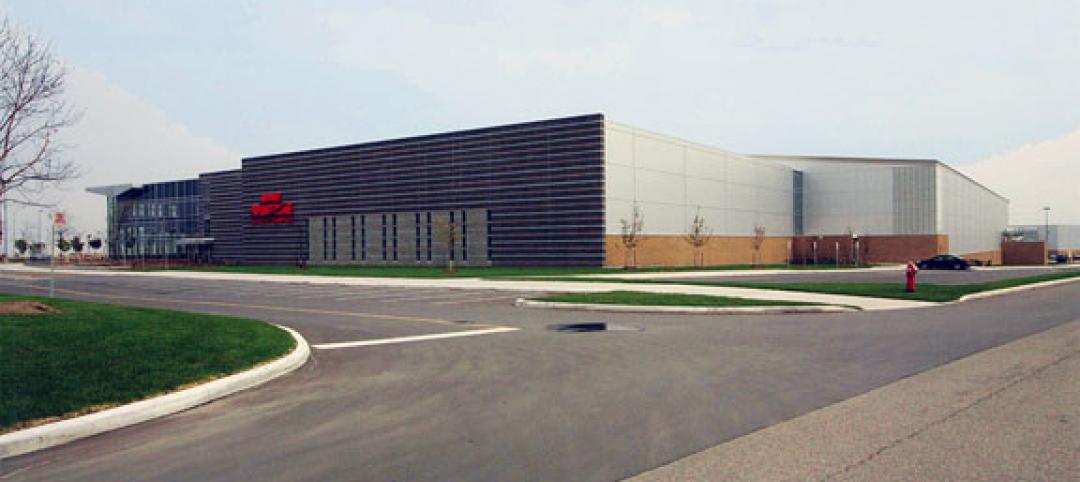The 65th Street Lincoln Center pavilion in New York, a multi-use project housing Lincoln restaurant, the new Elinor Bunin Munroe Film Center, and the Laurie Tisch Illumination Lawn, has earned national recognition in the 2011 Innovative Design in Engineering and Architecture with Structural Steel awards program (IDEAS2).
In honor of this achievement, members of the project team will be presented with awards from the American Institute of Steel Construction (AISC) during a ceremony in the Hauser Patron Salon on the second floor of Lincoln Center's Alice Tully Hall, just across 65th Street from the pavilion, on Wednesday, November 9.
Conducted annually by AISC, the IDEAS2 awards recognize outstanding achievement in engineering and architecture on structural steel projects around the country. The IDEAS2 award is the highest, most prestigious honor bestowed on building projects by the structural steel industry in the U.S.
The project team members include owner Lincoln Center for the Performing Arts, New York; design architect and interior designer of the restaurant, Diller Scofidio + Renfro, New York; executive architect, FXFOWLE, New York; and architect and interior designer of the film center, Rockwell Group, New York; structural engineer Arup (AISC Member), New York; and general contractor Turner Construction Company (AISC Member), New York.
The 65th Street Lincoln Center pavilion is a National award winner in the category of projects $15 Million to $75 Million, making it one of only eight projects around the country to receive the National honor. Each year, the IDEAS2 awards honor National and Merit award winners in three categories, based on constructed value: projects less than $15 million; projects $15 million to $75 million; and projects greater than $75 million. Each project is judged on its use of structural steel, with an emphasis on creative solutions to project requirements; design innovation; aesthetic and visual impact of the project; innovative use of architecturally exposed structural steel; technical or architectural advances in the use of steel; the use of innovative design and construction methods; and sustainable design.
Lincoln Center for the Performing Arts is one of the largest and best-known arts complexes in the world, with 12 independent companies and 15 venues bringing a wide range of events to five million visitors per year. Over the past decade, the center has undertaken an ambitious modernization of its midcentury campus. The central design challenge: reactivating the connection between the 16-acre campus and its Manhattan neighborhood, increasing the visibility of resident organizations and drawing in new audiences.
One of the key architectural solutions to emerge from the modernization project is the new 65th Street Lincoln Center pavilion. Topped by a striking warped green roof and housing a glass-walled restaurant, the pavilion is a distinctive yet accessible urban form that fulfills complex programmatic requirements while maintaining much-needed public space on the campus.
In addition to creating an iconic shape that stands out among its rectilinear neighbors, the pavilion's unique geometry addresses a number of practical concerns. The lowest point of the structure brings the roof flush with the plaza, extending a friendly invitation onto the grass to both Lincoln Center patrons and casual passerby. The twisting planes tilt the 7,200-sf lawn away from 65th Street, reducing visitors' exposure to noise and traffic.
"This pavilion is a substantial element delicately inserted into an existing urban space," commented Robert Theel, AIA, regional chief architect and director, Design & Construction Division, General Services Administration Great Lakes Region, Chicago, and a judge in the competition.
The open, serene atmosphere is carried into the 11,000-sf restaurant, called Lincoln, which features an exposed central kitchen flanked by four public dining areas. Glass walls and a contoured mahogany ceiling frame views to the outside and draw the public's gaze inward. Accessible from both plaza and street level, Lincoln has been praised as one of the nation's best new restaurants since its September 2010 launch.
The simple, streamlined form of the pavilion gives no indication of the complex, densely packed facilities beneath. In addition to three new subterranean Lincoln Center Film Society theaters, the restaurant sits atop the central utility plant, which provides chilled water and stream to the entire campus.
The layout for the geometry of the pavilion's steel superstructure follows the mathematical principals and main generating lines of a rectilinear hypar. As a result, straight steel members were able to be used for all floor beams. Thoughtful rationalization of the architectural form and use of steel for the primary structure simplified fabrication and enabled rapid construction. The latter was particularly important due to Lincoln Center's need to remain open throughout the design and construction process. The design team and contractors exchanged 3D models, further easing fabrication and aiding interdisciplinary coordination.
Arup's structural design thoughtfully addresses the requirements of each programmatic element. Metal decking with concrete poured on top forms the warped floor structure. Columns at regular intervals transfer vertical loading into the existing building. An additional layer of transfer beams underneath the columns transfers vertical loading around the movie theaters and the central mechanical plant into existing footings. On one end, the lower tip of the hypar sockets into the existing waffle slab of the plaza, allowing the transfer of lateral loading into the existing shear diaphragm. On the opposing side, braced frames transfer horizontal loading into the ground.
Throughout the five-year design and construction period, the project team created and coordinated multiple document packages corresponding to the logistical challenges and sequencing of the work, consistently exercising a high level of oversight to minimize conflicts and mitigate unforeseen field conditions.
The new pavilion and improved facilities will enable Lincoln Center to continue providing world-class performances to local, national and international audiences for decades to come. With its unique space-generating structure, complex interface of new and old, and challenging logistical and scheduling requirements, the pavilion pushed New York City's design and building community to the boundaries of existing construction technologies.
The 14 IDEAS2 winners for 2011 were chosen from nearly 100 submissions received by architectural and engineering firms throughout the U.S. Each submission is reviewed and award winners are selected by a nationally recognized panel of design and construction industry professionals.
The IDEAS2 award dates back over 70 years to the earliest years of AISC's existence. Roger E. Ferch, P.E. president of AISC, said, "The entire 65th Street Lincoln Center pavilion project team has shown how structural steel can be used to create structures that combine beauty and practicality. The result is a pavilion that serves its patrons extremely well, while providing an example of what can be achieved when designing and constructing projects with steel." BD+C
Related Stories
| Sep 19, 2012
Sasaki opens office in Shanghai
Office supports firm’s present and future work in China, throughout Asia.
| Sep 18, 2012
MBMA partners with ORNL for whole building energy efficiency study
The results are intended to advance energy efficiency solutions for new and retrofit applications.
| Sep 18, 2012
MKK opens office in North Dakota
MKK is currently working on seven projects in North Dakota, including a hotel, restaurant, truck stop, office building, and apartment complex.
| Sep 18, 2012
Firestone Building Products launches new website
Deep product information and innovative customer support tools are highlights.
| Sep 13, 2012
Leo A Daly Company promotes Kraskiewicz to senior vice president
Kraskiewicz, who most recently served as chief operations officer for the Leo A Daly division, will guide brand management, business development, operations and financial performance for 18 offices worldwide.
| Sep 13, 2012
Acentech adds audiovisual expertise to Trevose, Penn. office
Artese focuses on advising, overseeing, and maintaining the client’s vision for the project from the initial kick-off meeting to the final commissioning of the completed systems.
| Sep 13, 2012
Margulies Perruzzi Architects completes office design for Pioneer Investments
MPA updated the office design and additional support space consisting of five floors at Pioneer’s Boston office located at 60 State Street.
| Sep 12, 2012
Harvesting new ways to eliminate waste at the USDA
After installing 20 high-speed, energy-efficient hand dryers in restrooms throughout the USDA headquarters; the USDA reports seeing an immediate 50% reduction in the use of paper towels.
| Sep 11, 2012
RTKL appoints Lance Hosey as Chief Sustainability Officer and Senior Vice President
Author and authority on green design to spearhead RTKL Performance-driven DesignSM initiative.
| Sep 11, 2012
McQuade appointed CEO of Tishman Construction
McQuade will focus on driving the growth of the company into new markets and expanding market share in its current areas of operation.

















